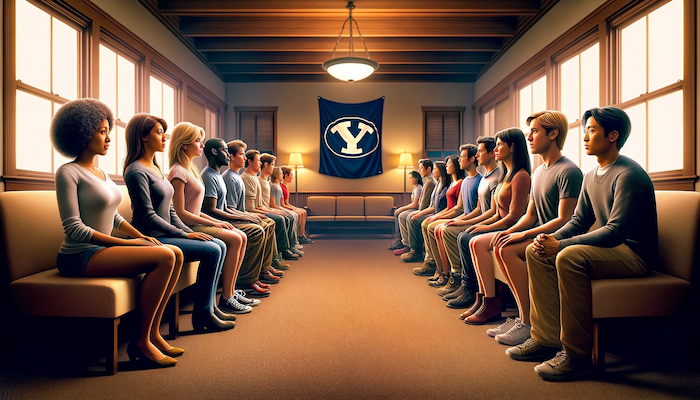There is an old wive’s tale about students who attended BYU or BYU Idaho holding what is now referred to as a “Mormon gazing party.” The story exists in different varieties but the core details suggest that a “Mormon gazing party” would hypothetically go as follows:
1. Members of opposing sexes form two distinct lines aligned to face each other.
2. The lights are to be turned off to allow both parties time to undress and become completely nude.
3. Once undressed, the lights are to be turned on again but only for a short amount of time.
4. With the lights now turned on, the purpose of event now begins – members of the opposite sex would then “gaze” at each other until the lights are turned off.
5. With the lights now off and the gazing complete, everyone would then get dressed again.
An important characteristic of the folklore is that whatever time allotted for the lights to be on is strictly to be for viewing purposes only. Participants implicitly or explicitly understand that they are not to leave the line, but are supposed to, or allowed to, view the nude participants on the opposing side of the line only.
Some important clarifying details about “Mormon Gazing Parties”
- The term “Mormon Gazing Party” is not a term that most Latter-Day Saints would be familiar with. The term does not show up in any historical documentation considered to be cannon or important to the church. In other words, it’s certainly not a term that was coined by anyone representing the church. The origin of the name is unknown.
- The term “Mormon Gazing Party” might suggest that such an event, under certain circumstances, is a church sponsored or sanctioned ceremony. On the contrary, such an event as described above would take place outside, or beyond the recommendation of any church protocol or clergy approval.
- While its possible “Mormon gazing parties” have happened. Their occurrence is not a well-documented phenomenon. They are usually told as having had happened in the 70’s 80’s or 90s.
- The term was likely derived as a utilitarian description of a cultural phenomenon from someone outside of the church.
Why would Mormon’s do this?
This is the real question.
Members of The Church of Jesus Christ of Latter-day Saints grow up with clear rules about modesty, sex, and dating. For a lot of LDS teens, those rules are stricter than what their non-LDS friends experience. At the same time, LDS young adults have the same curiosity, attraction, and hormones as everyone else—nothing about that is different.
When you put those two things together, (strong rules and normal human desire) it can create pressure. Most 18-year-olds aren’t sitting around with fully formed philosophical arguments about why they believe what they believe. Instead, they often just know:
-
“This is what I was taught”
-
“This is what people expect of me”
-
“I don’t want to cross certain lines”
Because of that, some young people look for ways to get close to the line without technically crossing it. That’s where the idea of “loopholes” comes from—not because someone is trying to rebel, but because they’re trying to balance curiosity with the rules they feel responsible to follow.
Whether or not stories like “Mormon gazing parties” ever actually happened, they make sense as rumors because they reflect a real experience many young adults recognize: wanting to explore, while also wanting to stay within boundaries. The story says more about how people imagine that tension playing out than it does about actual Mormon behavior.
Related: What is “Mormon Soaking?” Defined and Explained by a Mormon
Related: What is “Durfing” Defined and Explained by a Mormon
